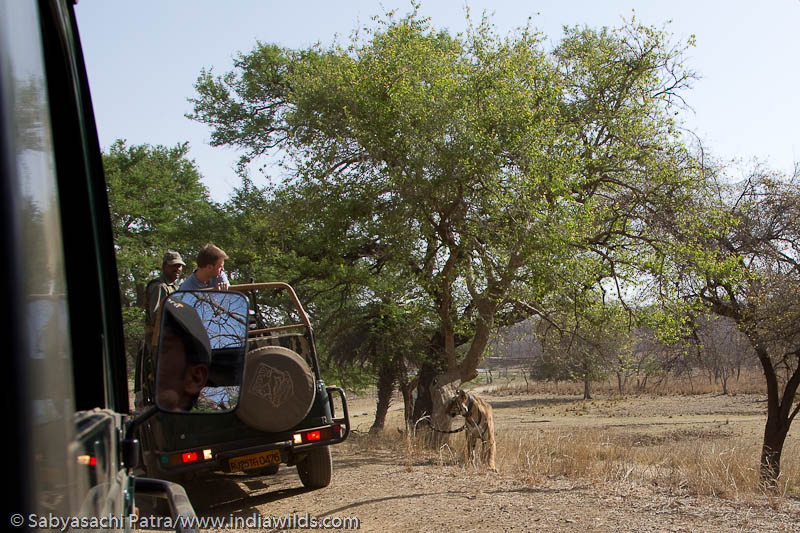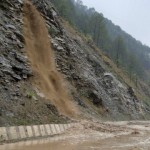IndiaWilds Newsletter Vol. 2 Issue V
I have been studying the African National Parks to glean best practices that can be implemented here in India. I have shared my learnings so far in the IndiaWilds Newsletters Vol. 1 Issue IX and Vol.2 Issue IV. In this issue, we examine the impact of tourism on tigers and the issues of crime and punishment.
Ranthambhore Tiger Reserve: Tourism Infrastructure
In the previous issue – IndiaWilds Newsletter Vol. 2 Issue IV (�http://www.indiawilds.com/diary/indiawilds-newsletter-vol-2-issue-iv ), I had done a comparative analysis of ecotourism practices in Botswana and India. Soon after writing that piece, I visited Ranthambhore Tiger Reserve. I could find time to do a brief analysis of the tourism infrastructure in Ranthambhore and its impact.
As we have said earlier, tourism infrastructure should not come at the cost of the wilderness areas. However, in Ranthambhore, the tourism facilities along with its supporting infrastructure is increasing day by day.
My analysis of Ranthambhore Tiger Reserve reveals that there are 454 seats available (Gypsy and canter) for tourist entry into the Tiger Reserve. So technically a maximum of 454 tourists can enter into the Tiger Reserve.
I found 33 hotels with 821 double rooms ie 1642 beds per night. This means at least three and half times more people can stay in hotels than the number of people who can enter the forest as tourists.
It should be kept in mind that most of these hotels allow triple occupancy. So the number of tourists potentially staying in Ranthambhore is higher. There are 2-3 hotels in the city with about 100 odd beds which I have not taken into consideration. There are also number of guest houses and basic stay options starting from Rs. 50 per night which have not been accounted for in my calculation. Now it is upto you to judge whether we need so many hotels and rooms in Ranthambhore.
Due to paucity of time, I could not find whether there are any applications pending for setting up new hotels in Ranthambhore. I am sure there would be many more real estate developers waiting to set up hotels in Ranthambhore.
Waste Management in Ranthambhore
Do these hotels practice responsible waste management measures?
Do they have basic waste disposal facility? Unfortunately, the answer is a big NO for most of the hotels. If you calculate that each tourist needs at least three mineral water bottles a day, then atleast five thousand mineral water bottles are consumed. Most of these are dumped in empty plots. Is this how we should treat our wilderness areas?
What is the need for conference facilities? I am sure, our wilderness areas can do without the added pressures of the ubiquitous sales meets and other such conferences.
Physical impact of tourism on Tigers:
There has been a flurry of news reports from the tourism lobby claiming positive impact of tourism on tigers. Let us examine the case of Ranthambhore again.
In a much celebrated case, a tourism group awarded life time achievement award to a tigress nicknamed Machhli. This tigress was earlier christened The Lady of the Lake by our Hon�ble Prime Minister Shri Manmohan Singh. This tigress had made the lake area her abode. Now her daughter has reclaimed the area and Machhli has moved away to a different zone. This tigress is called T17. She has been watching tourists from a young age and has got acquainted to tourists. Unfortunately, the tourist vehicles hardly allow her to move.
I have seen her trying to stalk deer but the tourist vehicles didn�t allow her to cross the road. In one instance, a tourist vehicle even screeched to a halt and hit the tail of the tigress. Fortunately, she didn�t lose her composure, but jumped aside and gave the driver a long hard look.
Wildlife Tourism was supposed to be non-consumptive. That means, you don�t take away anything from the forest and don�t have any negative impact. Unfortunately, the way wildlife tourism aka ecotourism is run in India, the impact on wildlife and wilderness areas is enormous. I hope, the Government wakes up to this grim reality and stops unrestrained tourism as it has a negative impact on our wilderness areas.
Crime and Punishment:
Today, I came across a news item from Bangladesh and immediately sat up and took notice.
Bangladesh which had promulgated its wildlife laws in 1974 is revamping it. Under the present laws, the maximum penalty for a wildlife poacher or smuggler is 2000 taka which is equivalent to Rs1316/- and a two year prison sentence. Under the soon to be enacted new laws, the sentence has been enhanced to life imprisonment and 3,00,000 taka (equivalent to Rs. 1,97,529/-).
Now it is in sharp contrast to laws in India. According to the current laws the maximum punishment for murdering an endangered species like a tiger is three to seven years in jail and a fine of ten thousand rupees for first offence and twenty five thousand for second offence.
It is said that the Government is interested in amending the laws to increase the punishment. The proposed punishments for killing a tiger is five to seven years for a first time offender and seven to ten years for a repeat offender. Needless to say that the present as well as the proposed quantum of punishment is not big enough to act as a deterrent.
A number of conservationists believe that it is more important to reform the prosecution process rather than enhancing the quantum of punishment citing the slow and tardy nature of the prosecution process. It is often difficult to prove the guilt. So often the poachers are not even convicted.
However, I would beg to disagree with people who feel the present level of punishment stipulated in the laws are sufficient or who feel that we need not focus our energy in enhancing it. Take the example of Indians who travel abroad. The so called elites, or the middle classes as well as the working class people like plumber etc are all very careful in obeying the rules in a foreign country like Singapore. The supposedly simple acts of indiscretion like spitting or defecating in public, which people here are so used to, is not at all practiced by our people in a country like Singapore. The level of punishments in the small country like Singapore acts as a big deterrent. If we are able to slap exemplary punishment for killing a tiger, then definitely the people on the ground who actually kill the tiger or act as conduits will refrain from doing so. We will then have a small amount of crime to contend with.
So what should be the punishment? If we look at some of the gruesome murders committed in India, like killing a person and skinning him or killing a person and burning her body in a tandoor (clay oven), the crime was adjudged to be rarest of the rare and the persons given death penalty.
Now let�s consider the crime in the jungle. The poachers lay snares to trap a tiger, the tiger is caught and remains hungry for a couple of days apart from bleeding due to its wounds. The tiger is then shot at point blank range and then skinned. The flesh and bones are dried and sent to be consumed in a country abroad. Do you think we should condone such cruelty? Is this not a rarest of the rare case and fit for capital punishment?
It is time, we toss away our rule books and rewrite those to keep in sync with the times.
Conservation in India:
How green are our corporates? An interesting article by Ranbir Mahapatra
The Green Monsters – About Big Corporates Hoodwinking us on their green ambitions
http://www.indiawilds.com/forums/showthread.php?t=3820
IUCN warns mangroves can get extinct:
http://www.indiawilds.com/forums/showthread.php?t=3762
Will replant mangroves 200kms away: to get permission for Navi Mumbai airport this is what the State Govt. says
http://www.indiawilds.com/forums/showthread.php?t=3882
Wilderness Updates:
Climate change hits Andamans:
http://www.indiawilds.com/forums/showthread.php?t=3777
A piece of good news amid the gloom:
Population of Dolphins rising in Mahanadi river mouth and Gahiramatha
http://www.indiawilds.com/forums/showthread.php?t=3749
Natural History:
Vulture Mating:
Perhaps the first documentation of vulture (Gyps indicus) mating in the wild.
http://www.indiawilds.com/forums/showthread.php?t=3815
(Members need to login to view it. In case you are a not a member of IndiaWilds then you can register with your full name with a space between first name and last name. Follow this for registration http://www.indiawilds.com/forums/register.php )
Wildlife Photography in India:
Some of the fine natural history moments recorded by our members:
Machhli with Kill by Jatinder Sawhney
http://www.indiawilds.com/forums/showthread.php?t=3736
Leopard Bandipur by Nikhilesh Mahakur
http://www.indiawilds.com/forums/showthread.php?t=3678
Elephant Digger by Dipankar Mazumdar
http://www.indiawilds.com/forums/showthread.php?t=3626
Serpent Eagle with Serpent Kill by Subramanya CK
http://www.indiawilds.com/forums/showthread.php?t=3804
Little Grebe by Amit Kalele
http://www.indiawilds.com/forums/showthread.php?t=3674
And clouds cover the jungle by Sagar Patil
http://www.indiawilds.com/forums/showthread.php?t=3876
Nature’s Pattern Matching: Young fronds of a Cycas by Rubens Alexander
http://www.indiawilds.com/forums/showthread.php?t=3715
Look forward to your inputs and your support in preserving the last tracts of wilderness and wildlife left in this beautiful country. For other interesting articles and photographs please check:
http://www.indiawilds.com/forums/
All the newsletters can be found online at: http://www.indiawilds.com/diary/category/newsletter
In case, anyone of you has forgotten his/her user id and password can email the admin at the following email id administrator@indiawilds.com
Regards,
Sabyasachi Patra
Profile: http://www.indiawilds.com/profile.htm
Contact: http://www.indiawilds.com/contact%20us.htm
Twitter: indiawilds
- GoPro Hero 12 Black - 6 September,2023
- Leopards: The Last Stand - 2 July,2023
- Drifting in the Waters of Sundarbans - 26 March,2023













Leave a Reply